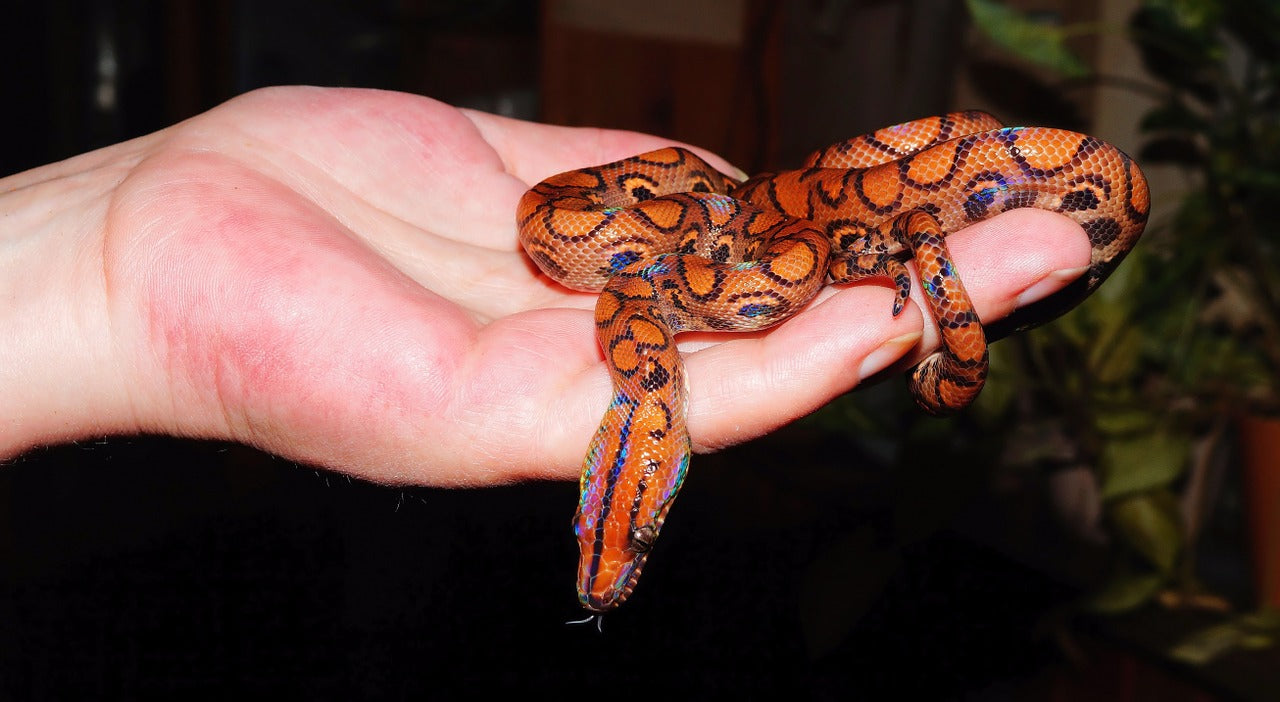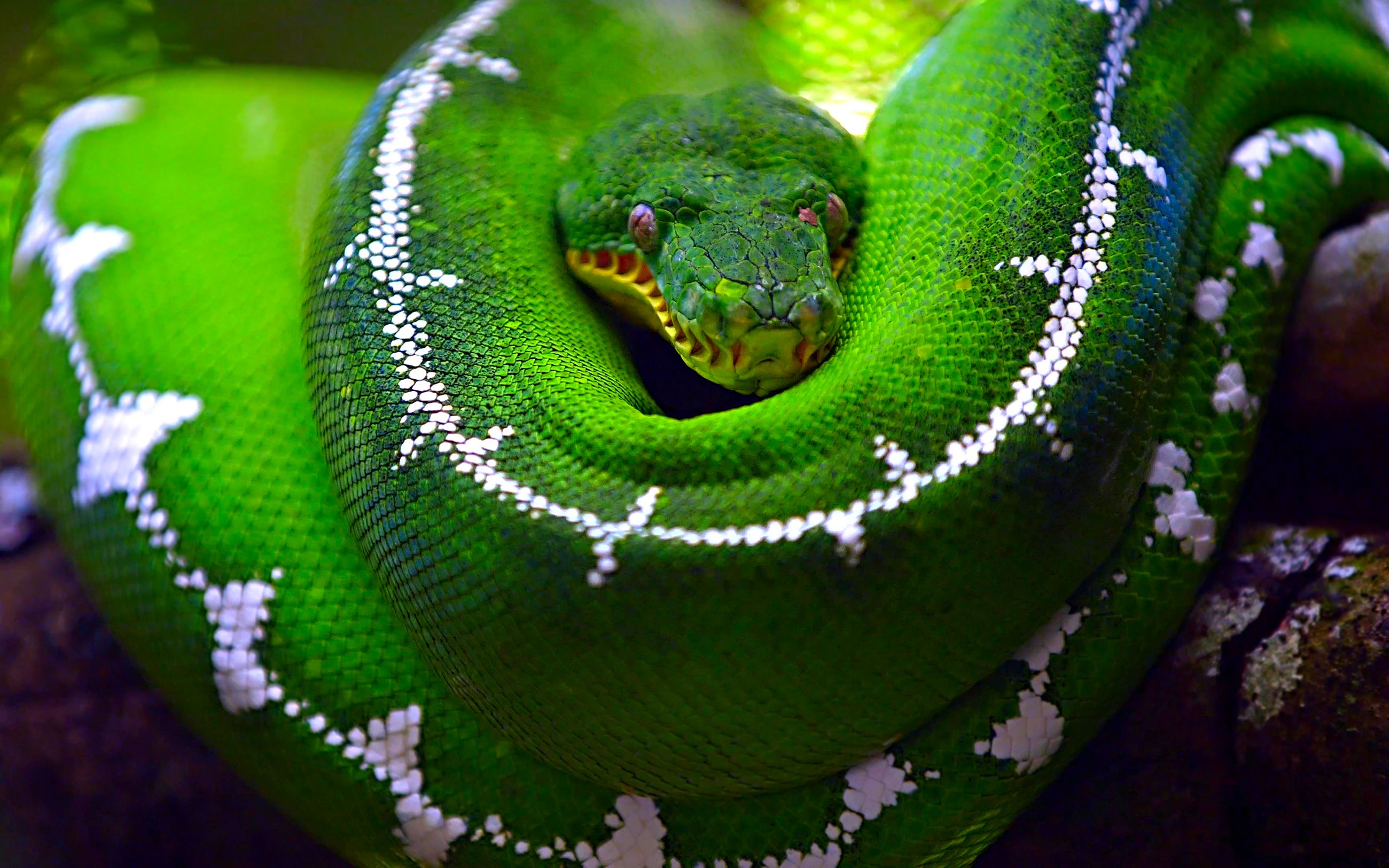Brazilian rainbow boas (Epicrates cenchria cenchria) are medium-sized, semi-arboreal, nocturnal snakes native to the central South America, particularly the Amazon River Basin area. They tend to prefer tropical rainforest for habitat, and divide their time between the forest floor, low branches, and swimming in bodies of water.
Rainbow boas typically grow to around 6’ long, although females are capable of growing larger. They have an oval head, slender body, and large labial (lip) scales. They are best known for their stunning color: Brazilian rainbow boas are typically vibrant red-orange with a pattern of contrasting rings and three stripes on the head. But most noteworthy is the incredible iridescence that gives them their common name.
Although there are several subspecies of rainbow boa, the Brazilian rainbow boa is the most common in the pet trade. Due to high humidity requirements and a somewhat nippy temperament as youngsters, these snakes are intermediate-level pet reptiles. With good care, they can live 20-25 years.
How much space do rainbow boas need?
Because rainbow boas are slender, it’s easy to think of them as smaller than they really are, keeping them in enclosures that are too small for them to stretch out fully, explore, and climb. The minimum for appropriately keeping one adult rainbow boa is 48”L x 24”W x 24”H. This is just the minimum, so using larger dimensions is beneficial and will happily be used!
Cohabitation (keeping multiple rainbow boas in one enclosure) is not recommended, as this is not a social species, and keeping them together causes competition and stress.
Do rainbow boas need UVB?
They seem to be able to survive without it, but it’s still best practice to provide UVB lighting for optimal health and wellbeing. Providing UVB lighting to your snake gives them all of the vitamin D that their body needs, stimulates better appetite and activity, and generally allows them to be healthier than they would be without.
The best UVB bulbs for rainbow boas housed in a 48” x 24” x 24” enclosure are:
- Arcadia T8 6%, 24”
- Zoo Med T8 Reptisun 5.0, 24”
The UVB bulb should be housed in a reflective fixture and placed close to the heat lamp, about 8-13” above the basking branch if over mesh, and 10-15” above the basking branch if not. UVB is blocked by glass and plastic, so you can’t give your snake UVB by placing its terrarium in front of an open window. Also make sure that the fixture your UVB bulb is in does not have a clear plastic bulb cover. UVB bulbs decay over time, so don’t forget to replace your bulb every 12 months to maintain good performance.
Lights should be on for 12 hours/day.
What basking temperatures do rainbow boas need?
Like other reptiles, rainbow boas are ectotherms, which means that they need a temperature gradient in their enclosure to help them regulate their metabolism and stay healthy.
Rainbow boas need a warm side temperature between 84-86°F. On the other side of the enclosure, the temperature should be around 73-75°F. Measure air temperatures in these locations with digital probe thermometers, with each probe placed in the desired area.
Provide heat for your snake by imitating the sun with a cluster of at least two halogen heat bulbs placed on one side of the enclosure, positioned over a sturdy basking branch or warm hide. Do not use ceramic heat emitters (CHEs), red bulbs, or blue bulbs, as these are not as effective.
Heating should be turned off at night. If your home gets particularly cold at night, you can use a CHE or radiant heat panel to maintain minimum ambient temps.
What humidity levels do rainbow boas need?
Rainbow boas dehydrate easily, and need an average humidity of 70-80%, as measured by a digital probe hygrometer placed in the middle of the enclosure. It’s essential to install a humid hide for your snake on the cool side of the enclosure, lined with moistened sphagnum moss, where they can access humidity levels of 90-100%.
Misting your snake’s enclosure with a sprayer first thing in the morning and again at night will help create the right humidity levels. If you need more, installing a cool mist humidifier connected to a hygrostat for use at night can be helpful.
These snakes also tend to like soaking, so make sure to provide a tub of water large enough to accommodate their entire body. Keep the water in this tub clean at all times, and scrub with animal-safe disinfectant once a week.
What substrate is good for rainbow boas?
Rainbow boas require a thick layer of moisture-retentive substrate to cushion their bodies and help maintain healthy humidity levels. As an added perk, it also tends to make the enclosure more attractive.
Ideally, this substrate should resemble what rainbow boas naturally live on in the wild: tropical soil. It should have small particles and hold moisture well. We recommend the following substrates for rainbow boas:
Layering clean, chemical-free leaf litter on top of the substrate can also help with humidity.
Substrate should be at least 4” deep and completely replaced every 3-4 months. Remove poop and urates daily, along with contaminated substrate.
What décor can you use in a rainbow boa terrarium?
It’s terribly boring for a snake to be stuck in an enclosure with nothing in it except substrate, a branch, and a water bowl. It doesn’t matter how big the enclosure is if you don’t put things in it for your pet to use and interact with.
Décor options include:
- thick vines
- branches
- cork tubes
- ledges
- live or artificial plants
Whatever you choose to use, make sure that the snake has cover to hide in so it can feel secure in its environment.
What do rainbow boas eat?
Like other snakes, rainbow boas are carnivores, which means that they need to eat whole animal prey in order to get the nutrition that they need. Here is a basic feeding schedule based on snake age:
- Hatchlings and juveniles should be fed once every 5-10 days.
- Adults should be fed once every 14 days.
Prey items should be roughly the same width as the snake at its widest point. Prey options include mice, rats, gerbils, hamsters, small guinea pigs, chicks, and quail.
Although live prey can be used, it’s safest and most humane to use frozen instead. Prey should be thawed in a plastic bag in warm water to approximately 100°F before offering with a pair of soft-tipped tweezers.
Supplements
Snakes can survive without vitamin or mineral supplements, but occasionally using them can help prevent nutritional deficiencies and optimize your pet’s health. We recommend Repashy Calcium Plus LoD.
Do rainbow boas like to be handled?
Few reptiles actually “like” to be held, but once they’re past the nippy baby phase (lasts about a year), rainbow boas generally tolerate human interaction well, and handling them regularly helps keep them tame. Here are some basic rules for handling snakes:
Wait at least 2 weeks before attempting to handle a new boa. Babies and juveniles tend to be more nervous and defensive than adults. Be gentle, and pick up the snake from below rather than from above. Support as much of its body as possible, and NEVER pick a boa up by its tail! Keep handling sessions brief at first, and always end them on a positive note, with the snake acting calm.
*This care sheet contains only very basic information. Although it’s a good introduction, please do further research with high-quality sources to obtain additional information on caring for this species.
Image by Karsten Paulick from Pixabay




Leave a comment
This site is protected by hCaptcha and the hCaptcha Privacy Policy and Terms of Service apply.